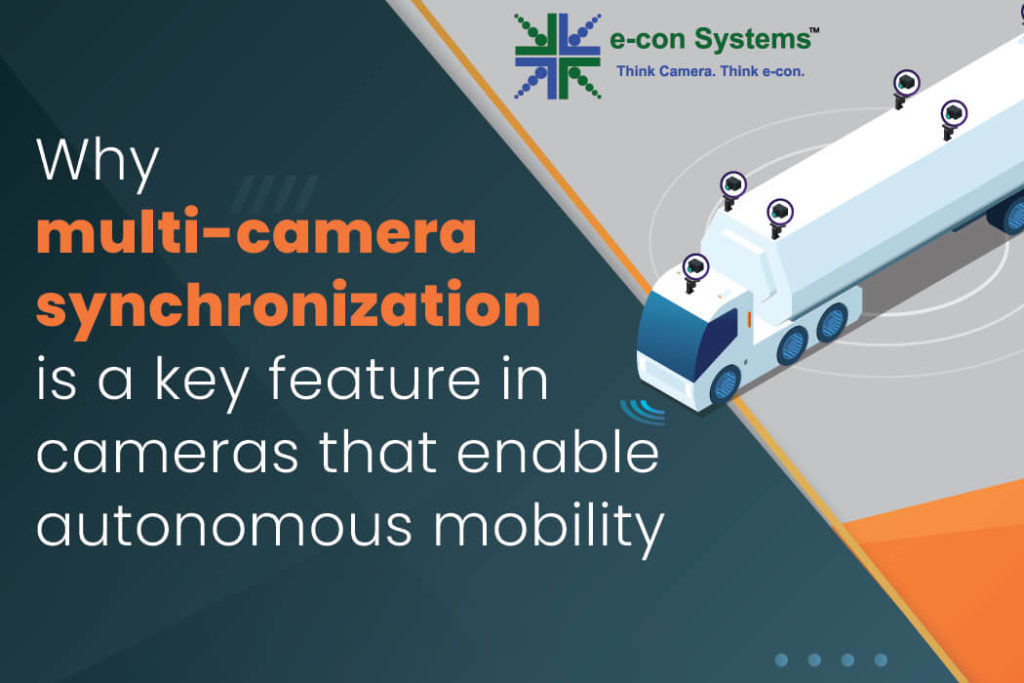This blog post was originally published at e-con Systems’ website. It is reprinted here with the permission of e-con Systems.
In this blog, you’ll learn about the key role played by multi-camera synchronization, how it works, and examples of autonomous vehicles using this path-breaking technology.
Embedded vision is a fundamental component of autonomous mobility systems, ensuring that they achieve undeniable levels of accuracy, reliability, and safety. Hence, it is no surprise that more autonomous robots and vehicles are getting equipped with high-resolution cameras. When paired with advanced processors, these cameras help the robots navigate and interact with their environments effectively.
The selection of these cameras is based on specific criteria such as sensor type, resolution, and frame rate. The primary function of these systems is to capture, process, and analyze visual data for tasks like object recognition, obstacle detection, and navigation. At the core of this autonomous innovation lies multi-camera synchronization.
In this blog, you’ll learn about the key role played by multi-camera synchronization, how it works, and examples of autonomous vehicles using this path-breaking technology.
Understanding Multi-Camera Synchronization
Strategic placement
As you can imagine, camera placement is critical in autonomous vehicles. Cameras are installed at predetermined points around the vehicle, selected based on the vehicle’s design and the intended use case. This arrangement ensures comprehensive coverage, enabling the system to gather visual data from all angles, providing a complete 360-degree field of view.
The strategic placement also takes into account the field of view of each camera, ensuring minimal overlap and maximum coverage. This is especially demanding in complex environments where capturing spatial data is the backbone of navigation and obstacle avoidance.
Synchronization
Synchronization in multi-camera systems is a complex process that ensures all cameras operate in unison, capturing images at precisely the same moment. This synchronization is achieved through a combination of hardware and software mechanisms.
Hardware synchronization often involves using a common clock signal to trigger image capture simultaneously. Software synchronization may involve time-stamping each image frame and aligning them in post-processing. This precise synchronization is essential for creating a cohesive and accurate representation of the vehicle’s surroundings, which is necessary for real-time decision-making and navigation.
Applications of Multi-Camera Synchronization in ADAS
360-degree surround-view
Multi-camera synchronization creates a 360-degree surround-view, enhancing driver awareness and vehicle safety. This system integrates images from multiple cameras positioned around the vehicle to provide a bird’s-eye view of the surrounding area. It is invaluable in various driving scenarios, such as parking, navigating tight spaces, or maneuvering in busy traffic.
Image stitching
Image stitching is a direct application of multi-camera synchronization, where images from different cameras are combined to create a single, coherent visual. This is useful in providing extended lateral and rear views, which are required for performing tasks like safe lane changes and merging. The synchronized cameras capture overlapping fields of view, which are then digitally stitched together, ensuring smooth transitions.
Remote driving assistance
Multi-camera synchronization enhances remote driving assistance systems, where an operator remotely controls or assists the vehicle. The system can provide the operator with a clear visual representation of the vehicle’s surroundings. This is crucial for remote decision-making in unforeseen driving conditions. The operator, with access to real-time visual information, can better assess situations and provide accurate guidance.
Benefits of multi-camera synchronization in autonomous mobility
Situational awareness
Multi-camera synchronization provides autonomous vehicles with a comprehensive and cohesive view of their surroundings. This synchronized 360-degree coverage ensures that the vehicle is aware of its environment from all angles, significantly reducing blind spots and enhancing situational awareness.
Accurate spatial perception/ depth estimation
The ability to accurately gauge distances and understand the objects’ spatial relationships is a key advantage. Autonomous systems analyze images from multiple synchronized cameras to better estimate depth and perceive the 3D structure of the environment. It is required for tasks like safe lane navigation, obstacle avoidance, and precise parking maneuvers.
Reduced blind spots and false alarms
Multi-camera synchronization minimizes blind spots and reduces false alarms by strategically positioning and synchronizing multiple cameras around the vehicle to create a comprehensive 360-degree view. This view ensures that potential hazards are identified accurately from all angles, reducing the likelihood of false alarms. Synchronized multi-camera systems also provide real-time information to enable these systems to make informed decisions.
Precise mapping and localization
Each camera captures different aspects and angles of the environment, and when these perspectives are synchronized, they create a detailed spatial map. This helps the system to understand its surroundings accurately. Furthermore, the synchronized data from multiple cameras ensures accurate localization, enabling the vehicle to pinpoint its exact position within the map. It can be important for path planning and maneuvering, especially in complex environments.
e-con Systems’ multi-camera solutions for autonomous systems
e-con Systems, having been designing, developing, and manufacturing OEM cameras for 20+ years, has a strong track record of multi-camera system integration in various industries. Our unique advantage lies in our partnerships with leading sensor manufacturers like Sony, onsemi, and OmniVision, and as a key partner of NVIDIA, we deliver advanced technology solutions.
We specialize in streamlining camera evaluations, offering a range of multi-camera solutions for 2 to 8 camera systems with in-depth customization capabilities to meet specific needs.
Visit our Multi-Camera Solutions page or use our Camera Selector to explore our full portfolio.
For any queries or support regarding integration of multi-camera solutions into your autonomous systems, please contact us at [email protected].
Suresh Madhu
Product Marketing Manager, e-con Systems


